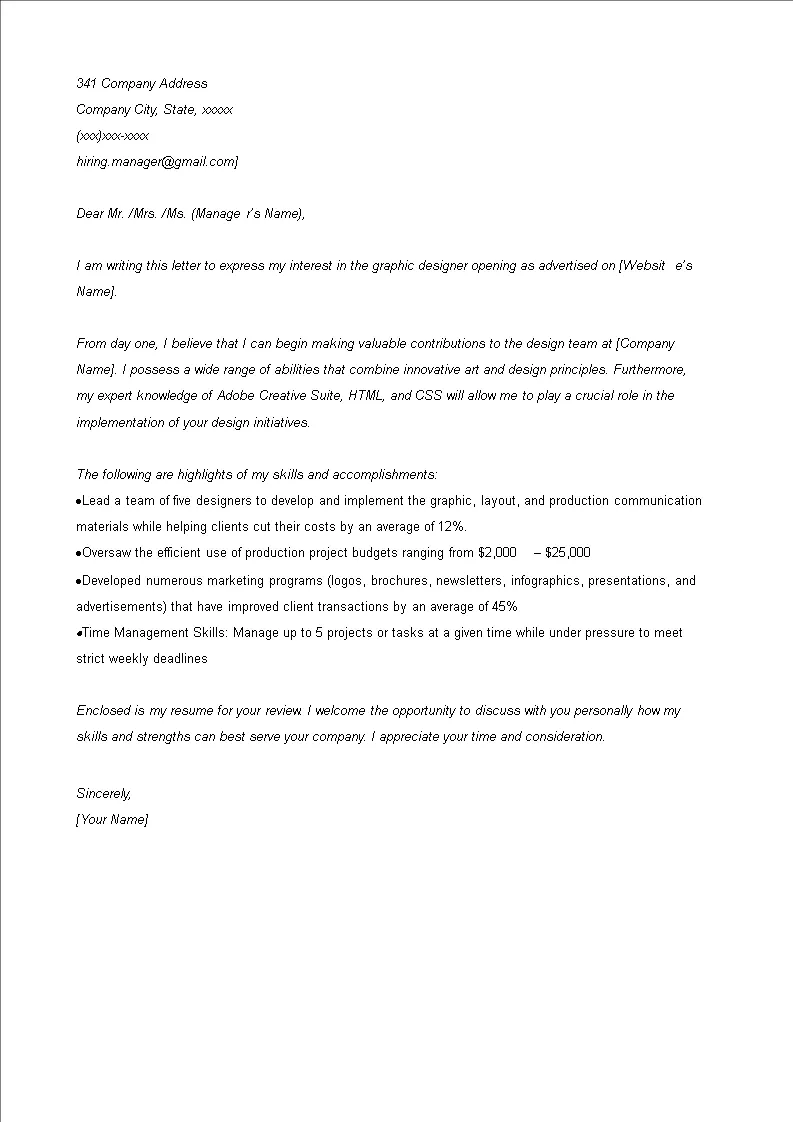Crafting a Compelling Graphic Design Cover Letter
A well-crafted graphic design cover letter is your first opportunity to impress a potential employer. It’s a chance to showcase your personality, highlight your skills, and demonstrate your understanding of the role. Unlike a resume, which provides a factual overview of your experience, a cover letter allows you to tell a story, connecting your qualifications to the specific needs of the job. This initial communication can make or break your chances of landing an interview, so it is crucial to invest time and effort in crafting a letter that stands out. The best cover letters go beyond simply listing your skills they articulate your passion for graphic design and demonstrate how you can contribute to the company’s success. This guide provides key tips and advice on how to create a cover letter that gets noticed and lands you your dream job.
Highlighting Your Design Skills
Your cover letter is the perfect place to spotlight the specific graphic design skills that align with the job requirements. Review the job description carefully and identify the key skills the employer is seeking, whether it’s proficiency in Adobe Creative Suite, knowledge of UI/UX design, experience with branding, or expertise in print design. Instead of just listing these skills, provide brief examples of how you’ve used them effectively in past projects. For example, instead of stating, ‘Proficient in Adobe Photoshop,’ you could write, ‘Utilized Adobe Photoshop to create photorealistic product mockups for XYZ client, resulting in a 20% increase in sales.’ Use action verbs to describe your accomplishments and quantify your achievements whenever possible. This approach demonstrates your competence and provides tangible proof of your abilities. Tailoring your skills section to match the job description will show the hiring manager that you are a well-suited candidate.
Showcasing Your Portfolio
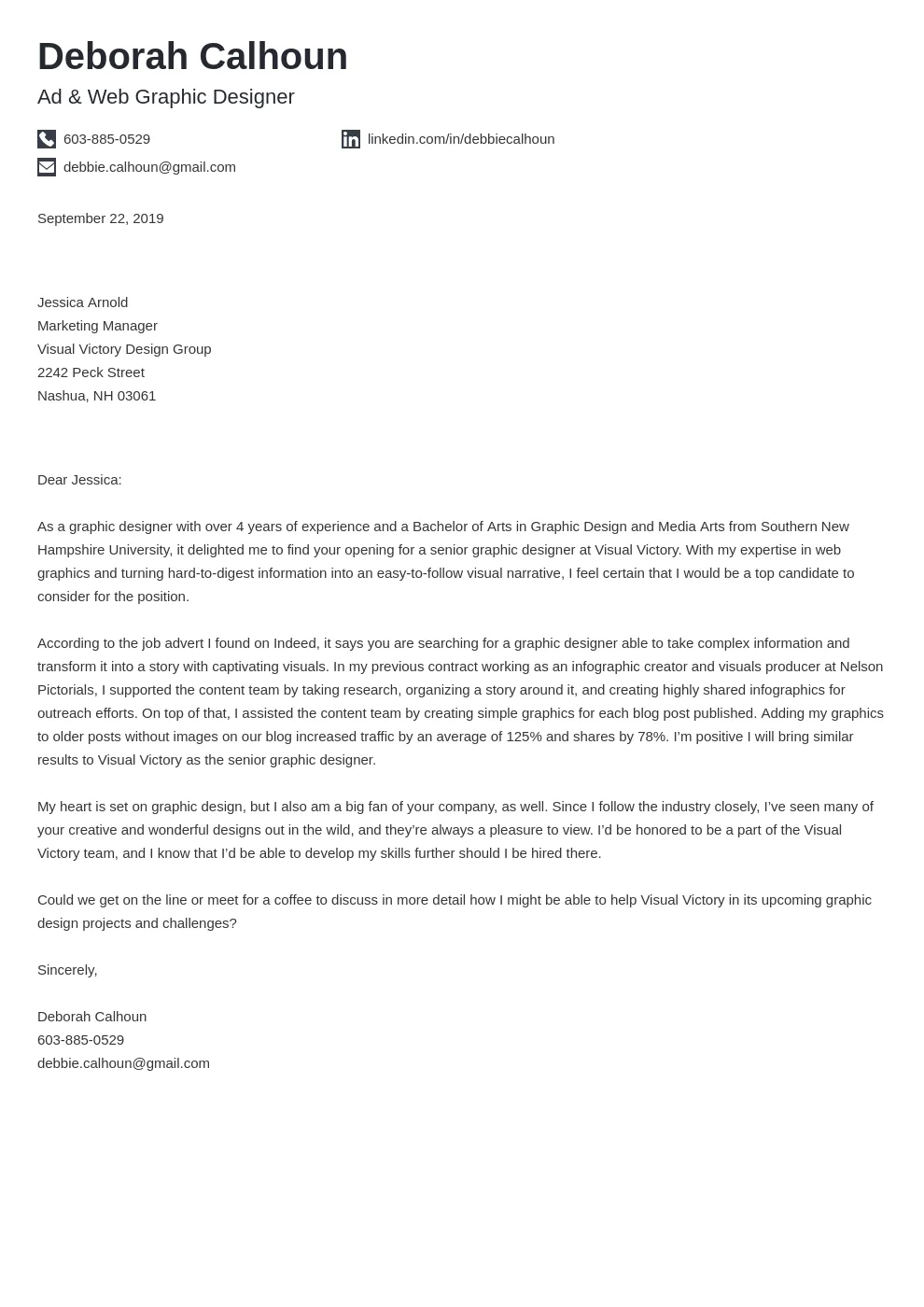
Your portfolio is your most valuable asset as a graphic designer, and your cover letter should effectively direct the reader to it. Your cover letter is the perfect opportunity to introduce your portfolio. Don’t simply state that you have a portfolio; instead, highlight a few of your most relevant projects and briefly describe your role and the results. If you’re applying for a role that requires web design experience, for instance, mention a website design project and emphasize your accomplishments, such as improving user experience or increasing conversion rates. Always include a direct link to your online portfolio, making it easy for the hiring manager to view your work. Consider including a QR code that links to your portfolio for physical cover letters. This strategy ensures that the hiring manager can easily access your work and see your design capabilities firsthand. Ensure your portfolio is up-to-date, well-organized, and showcases your best work, as it will be the ultimate determinant of your ability.
Tailoring Your Cover Letter to the Job
Generic cover letters are a major turnoff for hiring managers. To truly impress, you need to customize your cover letter for each job application. Research the company and the specific role to understand their needs and expectations. Demonstrate that you’ve read the job description carefully and address the specific requirements and responsibilities. This shows the hiring manager that you’re genuinely interested in the position and that you’ve taken the time to understand what they’re looking for. Mention specific projects or accomplishments that align with the job description, highlighting your relevance to the role. Showcasing your understanding of the company’s brand and design style will also set you apart from other applicants. Personalized cover letters demonstrate that you’re committed and eager to contribute to the company’s success. This attention to detail can significantly increase your chances of getting an interview.
Keywords and Action Verbs
Incorporate keywords from the job description throughout your cover letter to show that you possess the skills and experience the employer is looking for. Carefully review the job posting and identify the key terms and phrases used to describe the role and its requirements. Use these keywords naturally within your cover letter, especially when describing your skills, experience, and accomplishments. Also, use powerful action verbs to make your accomplishments more impactful. Instead of saying ‘responsible for,’ use verbs like ‘created,’ ‘developed,’ ‘designed,’ ‘implemented,’ ‘managed,’ or ‘achieved.’ Use action verbs to quantify your achievements whenever possible, showing the results of your efforts. For example, instead of saying ‘Improved website design,’ you could write ‘Increased website conversion rates by 15% through strategic design improvements.’ Highlighting your achievements using action verbs and keywords will demonstrate your value and increase your chances of getting noticed.
Formatting Your Cover Letter
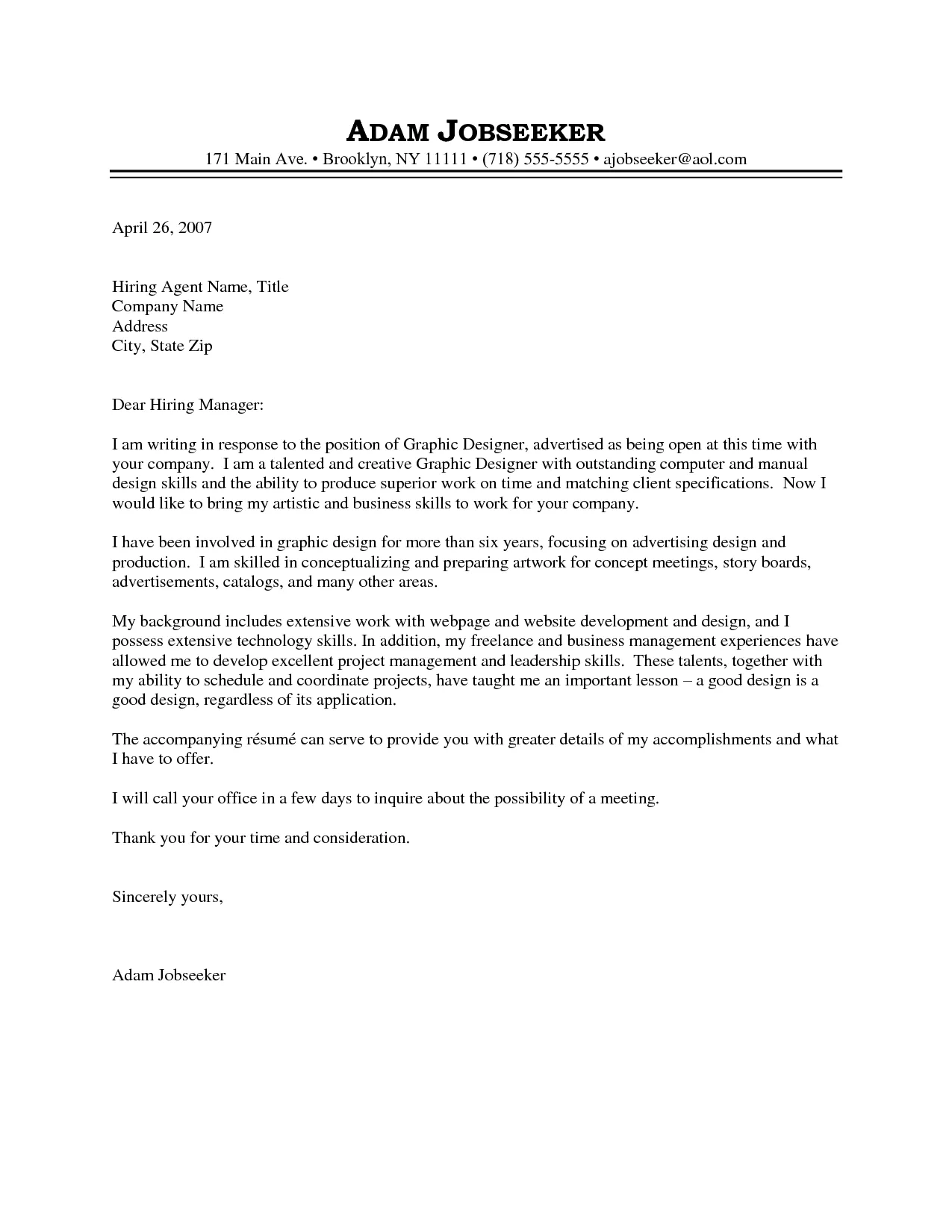
The formatting of your graphic design cover letter is just as important as its content. Clean and professional formatting reflects your attention to detail and professionalism. Use a standard, easy-to-read font like Arial, Calibri, or Times New Roman, and maintain a consistent font size throughout the letter. Keep the letter concise, ideally one page in length, and use clear headings and subheadings to break up the text and improve readability. Proper formatting makes it easy for the hiring manager to quickly grasp the key points of your letter. Employ proper spacing between paragraphs to make the letter visually appealing and easily digestible. Avoid dense blocks of text. The goal is to create a cover letter that is both informative and easy to read. An organized cover letter shows your professionalism and organizational skills.
Header and Contact Information
Your header should include your full name, professional title (e.g., Graphic Designer), contact information (phone number and email address), and your LinkedIn profile URL or portfolio link. Make sure your contact information is accurate and up-to-date. Consider including your portfolio link directly in the header. Add the date of your letter and the hiring manager’s name (if known) and title, along with the company name and address. Proper formatting makes it easy for the hiring manager to quickly learn your name and skills. Ensure your email address is professional-sounding (e.g., john.doe@email.com) and not something like ‘graphiclover123@email.com’. This attention to detail will make a good first impression.
Body Paragraphs The Core
The body of your cover letter is where you make your case. The first paragraph should state the position you’re applying for and how you found the job. Briefly mention why you’re interested in the company. The second paragraph is the opportunity to showcase your skills and accomplishments. Highlight your experience using the techniques described above. The third paragraph should express your enthusiasm and your reasons for wanting to work for the company. Show that you’ve researched the company and understand its values and goals. The goal is to convince the hiring manager that you’re the best candidate for the role. It’s a chance to connect your experience to the job’s specific needs.
Proofreading for Perfection
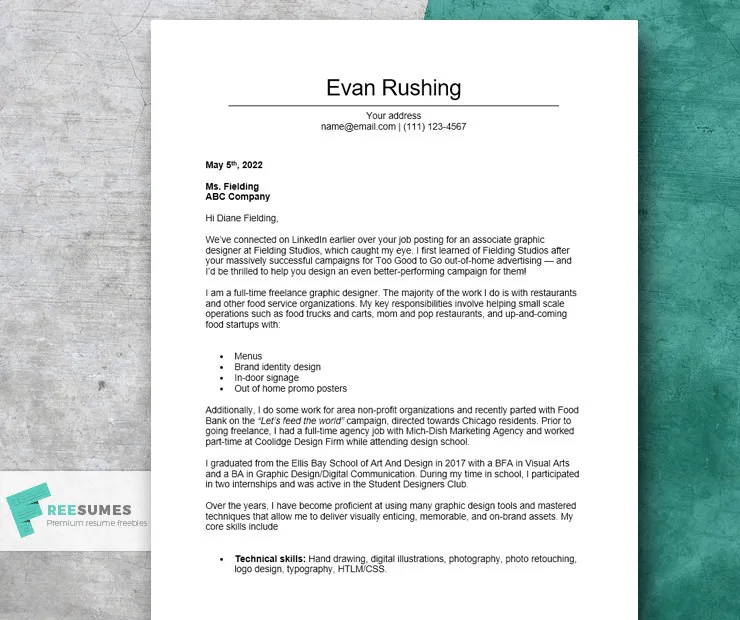
Before you submit your cover letter, meticulously proofread it for any errors in grammar, spelling, and punctuation. Typos and grammatical errors can make you appear unprofessional and can detract from your qualifications. Use spell-check and grammar-check tools, but don’t rely on them entirely. Read the letter aloud to catch any awkward phrasing or sentence structures. Have a friend or colleague review your letter for a fresh perspective and to catch any mistakes you might have missed. Ensure your letter is concise and well-written. A polished cover letter demonstrates your attention to detail and your commitment to quality. Proofreading shows the hiring manager that you care about the details.
Essential Elements of a Graphic Design Cover Letter
Your Passion and Enthusiasm
Graphic design is a field driven by passion and creativity. Let your enthusiasm shine through in your cover letter. Express your genuine interest in the company and the specific role you’re applying for. Explain what excites you about the opportunity and why you’re drawn to the company’s work. Share your personal design philosophy or values and how they align with the company’s mission. Being authentic and expressing your love for graphic design is an excellent way to make a positive impression. A passionate tone helps your cover letter stand out from the crowd. Don’t be afraid to showcase your personality and your drive to succeed in the design field.
Why You’re a Good Fit
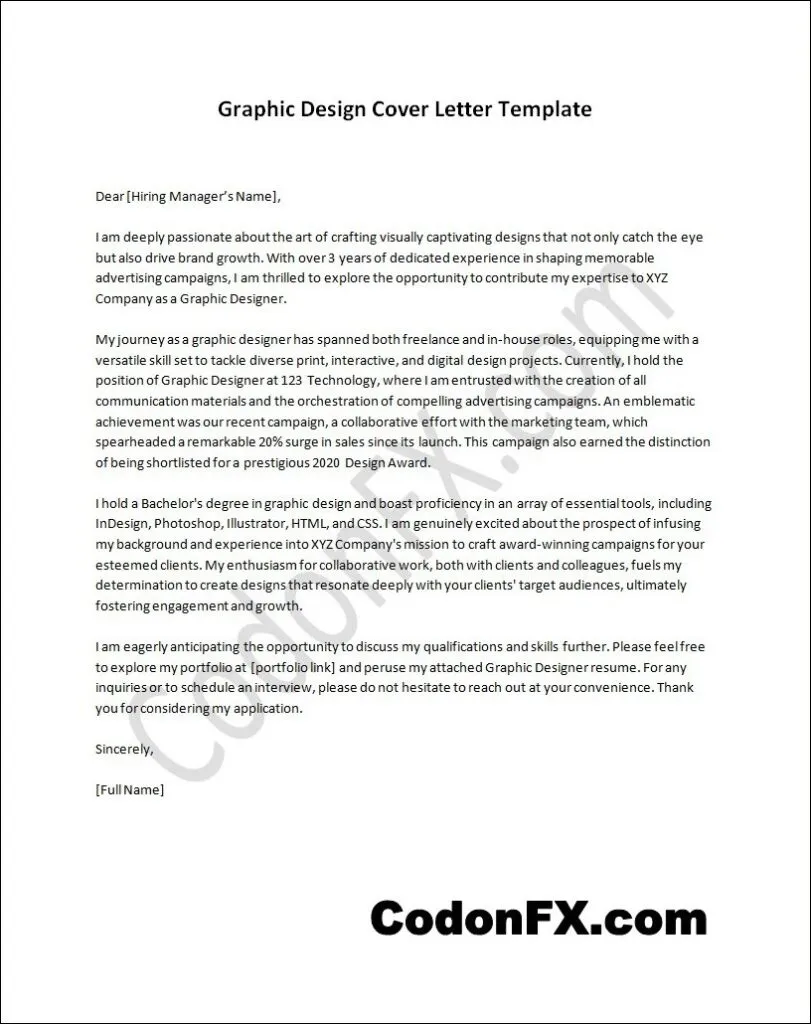
Clearly articulate why you’re a good fit for the specific role and the company. Explain how your skills, experience, and values align with the job requirements and the company’s culture. Refer to specific projects or accomplishments that demonstrate your ability to succeed in the role. Show that you’ve researched the company and understand their goals and values. Explain how you can contribute to the company’s success. Demonstrate that you’re not just looking for a job, but an opportunity to grow and make a meaningful contribution. A compelling explanation of why you’re a good fit will increase your chances of getting an interview.
Addressing the Hiring Manager
Whenever possible, address your cover letter to the hiring manager by name. This personal touch shows that you’ve taken the time to research the company and the hiring process. If you can’t find the hiring manager’s name, use a generic greeting like ‘Dear Hiring Manager’ or ‘Dear [Company Name] Team.’ Avoid generic greetings such as ‘To Whom It May Concern.’ Researching the hiring manager’s name and addressing them directly can improve your chances of getting your application noticed. This personal connection helps to establish a rapport and demonstrates your attention to detail. Making this small effort can make a big difference.
Closing the Letter
End your cover letter with a strong call to action. Express your enthusiasm for the opportunity and reiterate your interest in an interview. Thank the hiring manager for their time and consideration. Include a formal closing such as ‘Sincerely,’ ‘Best regards,’ or ‘Thank you.’ State your contact information, including your phone number and email address. Proofread your closing to ensure there are no grammatical errors. A well-crafted closing reinforces your interest and leaves a positive final impression. Ensure that your final impression underscores your interest and enthusiasm for the role. Reiterate your contact information for easy access.
